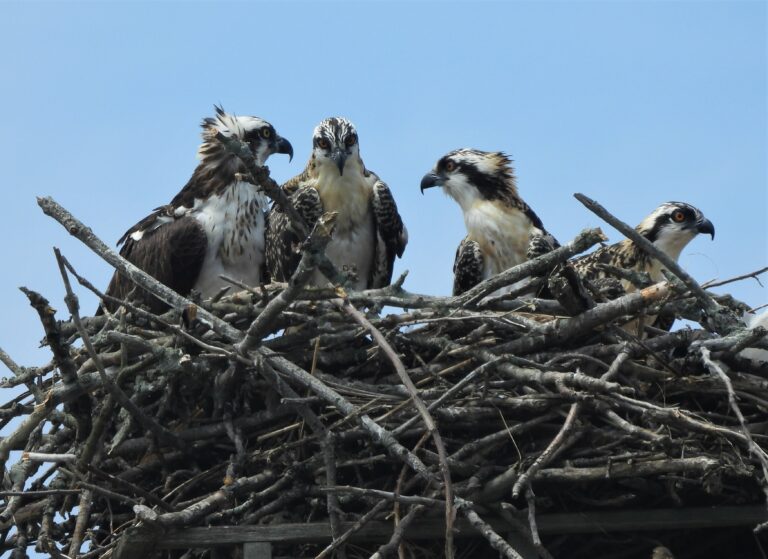
By Jennifer Wilson-Pines
Summer is the season of baby birds. The spring migrants have successfully arrived, found a mate, built or found a nesting site, laid the eggs, incubated and now are fetching an endless stream of food.
The year-round residents may have started earlier and are raising their second or even third brood of chicks. Robins, Starlings, House Sparrows, Cardinals, and Wrens all can produce several broods during the spring and summer. Some residents nest late, like American Goldfinch, which time their breeding to the bloom of thistles in July and August, offering both seed for food and thistle down to line their nests.
Birds have two different strategies for raising young, producing either Altricial or Precocial young. Songbirds and raptors (hawks, eagles and owls) incubate for a relatively short time and hatch blind, helpless babies that have to be protected and fed a steady diet of protein from insects and invertebrates for the small birds to small mammals and fish for the raptors.
These altricial chicks will remain in their nest area until they are ready to fly. Even after they have left the nest, the parents will continue to feed the young until they get the hang of finding food. Many young birds will change their diet at this time, no longer needing the protein for growth, and move on to their adult diet of seed or fruit. The transition to self-feeding is especially difficult for young raptors and owls. Their parents teach them to hunt, but ineptitude quickly leads to starvation. Many do not make it through their first year.
Some of the altricial chicks will jump nest before they are fully able to fly, but the parents will remain in the area and continue feeding them. Generally, this is only for two or three days, but this presents serious danger to the grounded babies from cats, dogs, raccoons and even other birds. Grounded babies that have eyes open and are feathered, not just downy, are not in need of rescue other than keeping pets away from that area for a couple of days.
The second strategy, practiced mostly by ground nesters, is to hatch precocial young that are mobile and active, though still flightless. Some of these birds feed their young, while others lead them to a food source. As with any broad category, there are varied adaptations.
By local ponds, Mallards and Canada Geese hatch precocial young who are ready to swim and feed within hours, though will not be able to fly for some weeks. They coordinate their broods by delayed incubation.
A female can only lay an egg every 24 to 36 hours, but trying to still incubate the last laid eggs while managing a flock of older active chicks would be a mother’s nightmare. So while the mother is laying eggs, she isn’t actively incubating until she is done, so all the young will hatch within a short period of time and remain together as they grow.
A trip to Nassau County’s Nickerson Beach on the south shore shows the variety of strategies. The large colonies of Common Terns, American Oystercatchers and Black Skimmer and smaller numbers of Piping Plovers provide good examples of varied tactics.
Oystercatchers are the first to hatch young in June. The chicks are able to follow their parents to the surf line, but the parents will also catch and crush small crabs for them to eat. Piping Plover chicks hatch shortly after and these tiny fluff balls must make the perilous trek to the surf to feed or forage in the less productive but safer puddles on the upper beach.
The huge colonies of Common Terns, on both east and west ends of the beach, hatch their chicks in early to mid July. Terns forage by diving for small fish, so the parents must feed their young until they are fledged. A constant stream of arriving parents with small silver fish firmly grasped in beak and departing to find more food keep the colony a hive of activity.
Black Skimmers are the last to nest, hatching their young in August. They feed by dramatically skimming the surface of the water with their huge lower mandible dipped in the water to snag any unlucky fish. Until flighted, the young must be fed.
If you go to Nickerson Beach to enjoy the spectacle of these active colonies, the beach officially opens at 9:30, parking $15 for residents, $35 for non residents, but the gates are not closed so earlier entry is possible. Many birds will bathe and drink fresh water from the small pond on the west side of the parking lot and dry off on the tarmac, allowing close viewing.






